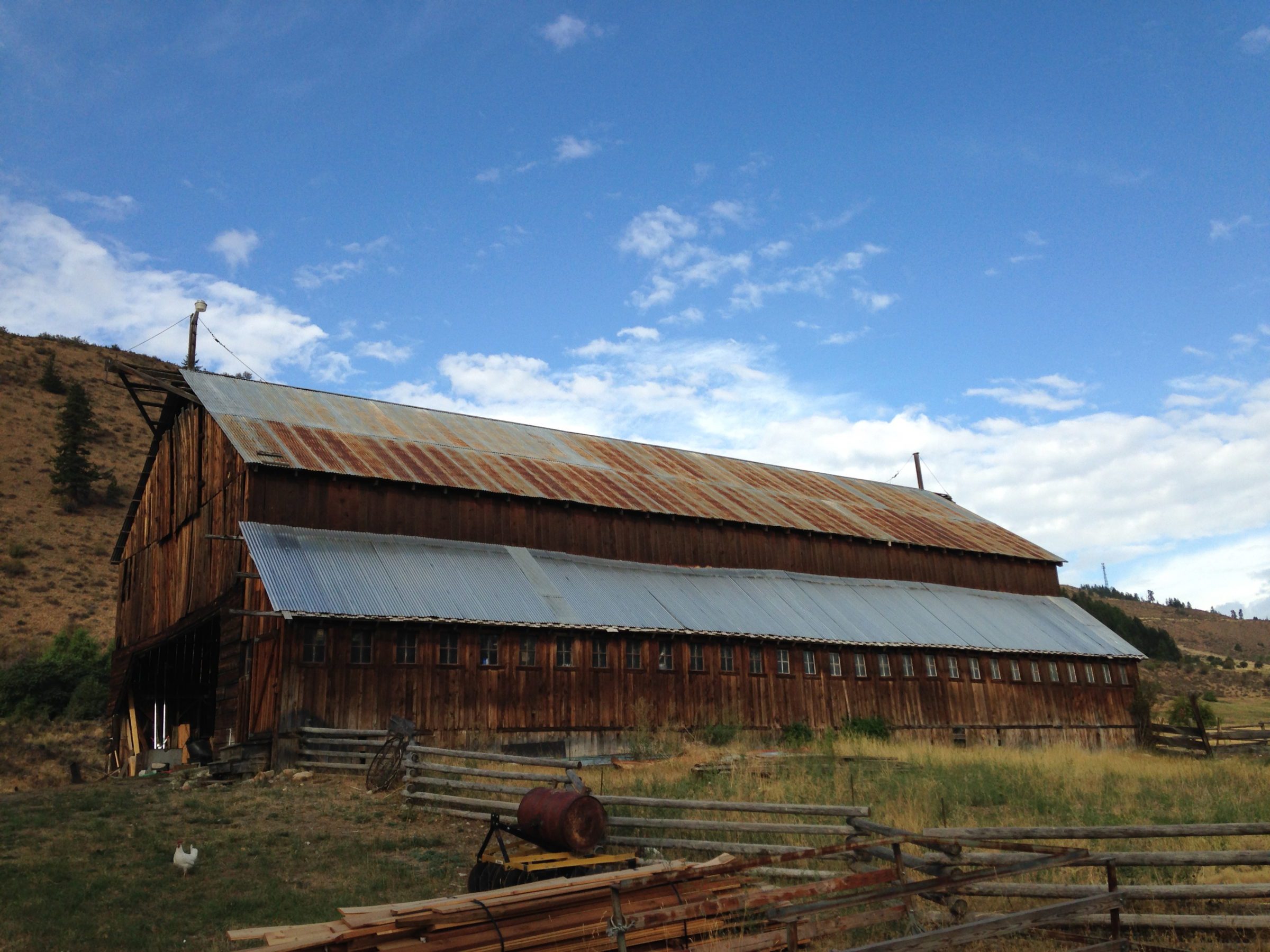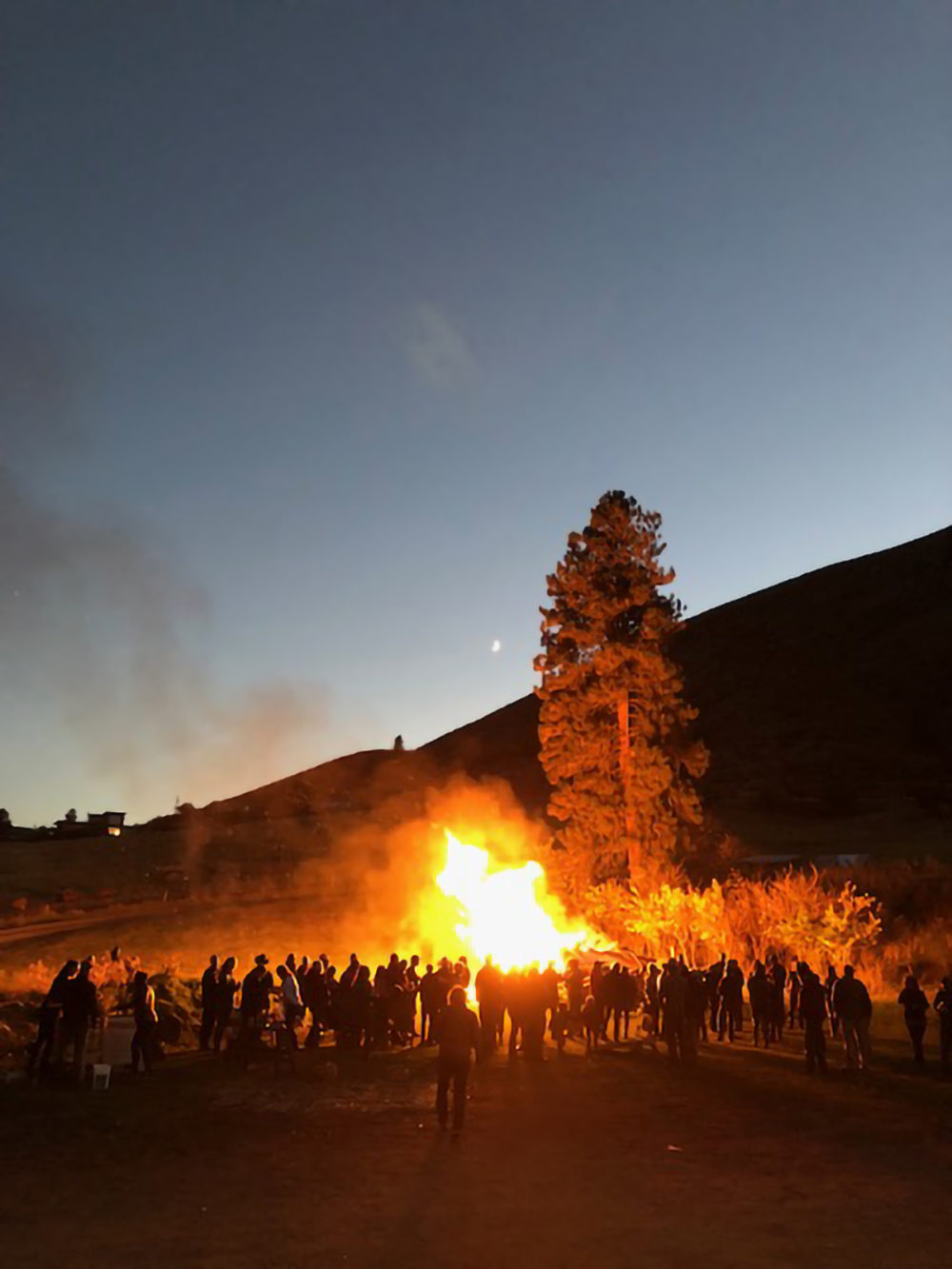Heritage Barns: Wild Plum Farm

Southeast view of the barn at Wild Plum Farm in 2015 before it received a Heritage Barn Grant.
By Deb Jones-Schuler
In the spring of 1997, we were searching for a new home in the Methow Valley, not at all certain what we’d find. The previous winter had been particularly hard on the region. Record snowfall followed by many inches of rain had left countless barns, sheds, and even a few houses crumpled in on themselves—the spring thaw was exposing heaps of rubble and despair. We hadn’t considered a barn to be a priority, but the more we looked, the more we realized a barn made a place feel like home for us—a standing barn even more so. As the realtor showed one property after another we grew discouraged that “our place” wasn’t to be found. And then, when all felt hopeless, we rounded the corner on Twin Lakes Road and saw it. Though there were more gaps than boards, though most of the 52 windows were missing or pocked with BB holes, though the farm debris lying about was overwhelming, we were in love. Instant, all-consuming love. This was our place! This was home.
We call it Wild Plum Farm for the plum trees at the foot of the hill, planted there long ago by an unknown farm resident, we imagine. Next to the trees, a Homestead rosebush blooms on my daughter’s June birthday, signifying that a house once stood nearby.
The original 160 acres of land was homesteaded by W.W. Easton in 1903 and called “Twin Lakes Ranch” for the two small bodies of water just east and a little bit south. In 1927, a Kentucky-born steel worker, John Pennington, partnered with Allen Wetsel to purchase the Twin Lakes Ranch for the development of a “modern dairy plant.” In the first year, the men built the existing barn to accommodate 90 head of dairy cows. Additionally, a “modern seven-room farmhouse and other modern buildings” were constructed. Over 400 tons of alfalfa were harvested each year.
In 1936, John Pennington returned to his native Kentucky, and the property was purchased by C.J. Ridge. Whether it continued as a dairy and alfalfa operation is unknown. Mr. Ridge lost the property to back taxes, and it was auctioned from the Okanogan County Courthouse steps in 1949. LeRoy Wright bought the farm at the sheriff sale and immediately resold it to the Remsburg Family. The Remsburgs came to Winthrop from Paul, Idaho. On Twin Lakes Ranch they farmed potatoes and built a potato packing shed along the Twin Lakes Road, the foundation of which is still evident today. Their market route extended north to Oroville and south to Wenatchee, and the Remsburgs farmed Twin Lakes Ranch until 1961. One old-timer remembers the Remsburgs as “the best potato farmers in the West!”
George Miller purchased the Twin Lakes Ranch in 1962, then down to 120 acres from the original 160. Mr. Miller altered the dairy barn to accommodate alfalfa hay storage and farmed the land until 1966. In 1963 he was named Washington’s Conservation Farmer of the Year for his efforts to conserve water. He had installed an underground irrigation pipe system that, according to his son, Carl Miller, reduced his usage by 50 percent. In 1966, Mr. Miller was forced to sell the Twin Lakes Ranch to pay down debts accrued by his oldest son. Grenville Clark, a Boston investor who came to the Methow on speculation that a railroad line would run from Wenatchee over the North Cascades to Seattle, purchased the farm and in turn leased it to local cattle ranchers Sandy and Shirley Haase. The Haase family worked the farm from 1968 to 1993, growing alfalfa and raising beef cattle.
In the early 1990s, John Blethen purchased the land and renamed it Sunnyview Ranch. He kept the Haase family on as ranch hands until 1993 but then divided the ranch into numerous parcels and built a new horse facility on the upper portion, along with a home on Patterson Mountain, overlooking Winthrop. Mr. Blethen sold the southern 40-acre parcel, including the original dairy barn and 7-room house, to our family in 1997, and that’s when our labor of love began.
With day jobs to pay the mortgage, little kids to raise, and heads full of dreams, we slowly picked away at making the rundown farm a home. For nearly 20 years, our efforts focused on cleaning up the broken-down buildings, rusted-out machinery, and various detritus from over a century of accumulated use. Acknowledging that the once-lazy county road was now a popular tourist route, we moved the farmhouse from the street to a sunny spot behind the barn in 2003, shielding it from the traffic noise.
In 2016, after years of living on a hope and a prayer that the old barn would last another winter, we finally had time and energy to devote efforts toward its restoration. With financial help from the Department of Archaeology & Historic Preservation’s Heritage Barn Grant Program, our in-house construction experience, a whole lot of elbow grease, and perseverance, we put the barn back together, giving it a new life and renewed functionality for years to come.
It was late in the summer of 2018 when the final touches to the restoration project were complete, and life was returning to a normal routine. As I coiled irrigation hose in the barnyard, a strange car slowly pulled up the drive. The windows rolled down, and I saw six smiling faces peering out from inside. A petite, white-haired woman sat in the passenger seat and introduced herself as Nila Pennington. At the golden age of 92, Nila is John Pennington’s last surviving child. Her nieces were taking her on a tour of her old homestead and the valley where she was raised.
Nila filled in gaps in the history not found in books and journals. Her father’s dairy failed when their 65 cows developed a fatal disease. John Pennington was unable to find work locally, so he returned to work in Kentucky while Nila, her two sisters, and mother remained in Washington. Nila had long wondered what had become of her beloved farm, having moved away from it in 1936 at the age of 10.
During the grant writing process, and later the restoration project, countless connections were made with old-timers with ties to the farm. It was a magical experience, listening to their reminiscences and imagining life in the early 1900s. Shirley Haase, now in her 90s; Carl and Claude Miller, in their 70s; Donna Martin, in her 80s—each had bits and pieces of history to share and fond memories of the farm during its many iterations. To celebrate the homestead and the old-timers’ history, and to give thanks for our community’s support, we threw a barn dance and pig roast in late October last year. Nearly 300 people, including three generations of the George Miller family, came out to the farm to visit, eat, dance, and reminisce about days of old. With music and dancing in the loft and a bonfire crackling in the barnyard, one could almost imagine a similar night in 1927 when, perhaps, the Pennington family celebrated the raising of their new, “modern dairy plant.”
Today, the barn stands as a regal reminder of days gone by. Under its restored majesty thrives a soap-making studio, farm mechanic’s shop, horse stalls and tack room, hay storage, and an agriculture bay for machinery and feed. The insurance agent now calls it “a beautiful asset”; we call it the heart and soul of Wild Plum Farm and our greatest love.
Immense gratitude and appreciation to the Washington Trust for Historic Preservation and the Department of Archaeology & Historic Preservation for giving us the opportunity to keep a little bit of history alive and well in North Central Washington.

South view of the barn at Wild Plum Farm in 2015 before it received a Heritage Barn Grant.

The west side of Wild Plum Farm barn under construction.

The south end of the barn at Wild Plum Farm after rehabilitation.

Deb Jones-Schuler and Nila Pennington.

The bonfire at the October 2018 barn dance celebrating the restored barn.
